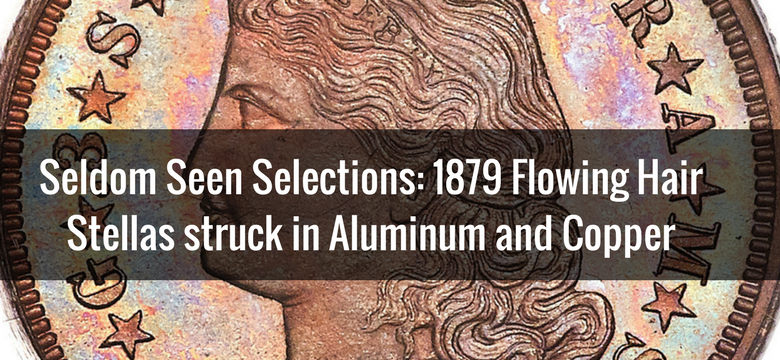In an effort to provide yet another outlet for the vast quantities of silver being mined in the western United States, John Adam Kasson proposed a four dollar gold piece, or Stella, which would be struck in a metric alloy containing 10% silver. The Stella was also one in a long line of ultimately futile attempts to create an international monetary unit. Kasson believed that the Stella would be readily accepted in Europe as well as the United States because its value approximated those of the Spanish 20 peseta, Dutch 8 florin, Austrian 8 florin, Italian 20 lire, and French 20 franc.
Enthusiastically responding to Kasson’s proposal, Alexander H. Stephens, Chairman of the Committee of Coinage, Weights, and Measures, requested that the Mint supply Congress with several patterns of Kasson’s proposed Stella. These presentation pieces were struck in gold (allegedly in metric alloy) using a design created by Charles E. Barber. The obverse depicts a head of Liberty facing left with flowing hair and a coronet inscribed LIBERTY. The inscription * 6 * G * .3 * S * .7 * C * 7 * G * R * A * M * S * is around the periphery, and the date 1879 is below. The denomination ONE Stella 400 CENTS is inscribed on a five-pointed star in the center of the reverse. The mottoes E PLURIBUS UNUM and DEO EST GLORIA are around the star, and the legend UNITED STATES OF AMERICA and another rendition of the denomination FOUR DOL. are around the periphery.
Before producing the 25 gold examples of the 1879 Flowing Hair Stella that were ultimately sent to Congressional leaders, the Mint apparently struck a few coins in other metals as trial pieces. According to USPatterns.com “over a dozen [copper pieces] are believed to be known.” Only a half dozen or so are known in aluminum, and a unique example exists in white metal. All of these coins have reeded edges, and a few have been gilt. Our Long Beach auction features two such pieces — a copper piece in Proof-66 brown and an aluminum example in Proof-67, both graded by PCGS.
1879 Stella in Copper
Judd-1636, PR66 Brown
1879 Flowing Hair Stella in Aluminum, Judd-1637, PR67
Only a Half Dozen Pieces Believed Known
The copper Stella has lovely subdued iridescence. Although certainly deserving the Brown designation, there is also a significant presence of deep red and blue over each side. The fields are brightly reflective and enliven the deeply patinated surfaces. The aluminum specimen has bright surfaces with the mirrored fields slightly subdued by a light, milky haze. For identification purposes we note three small obverse planchet flaws: in the upper left field below the first 7; in the upper left field to the left of the C; and in the upper right field running from Liberty’s hair to the star between G and R. There are three small dark spots on the reverse: on the right portion of the star; on the denticles at 4 o’clock; and on the denticles between 5 and 6 o’clock. The reverse has a similar planchet flaw in the lower right field below the second A in AMERICA.
These pieces are of the greatest rarity and importance to the pattern collector and should see spirited bidding before the hammer falls in Long Beach.
